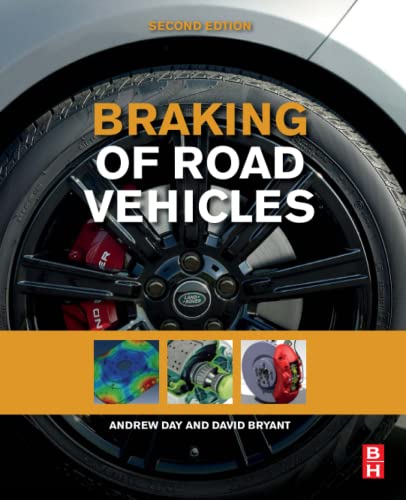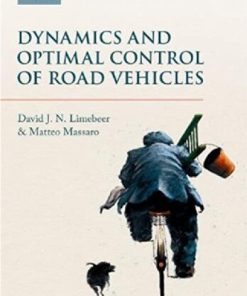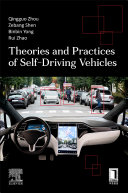(EBook PDF) Braking of Road Vehicles 2nd Edition by Andrew Day, David Bryant 0128220066 9780128220061 full chapters
$50.00 Original price was: $50.00.$25.00Current price is: $25.00.
Braking of Road Vehicles 2nd Edition by Andrew Day, David Bryant – Ebook PDF Instant Download/DeliveryISBN: 0128220066, 9780128220061
Full download Braking of Road Vehicles 2nd Edition after payment.

Product details:
ISBN-10 : 0128220066
ISBN-13 : 9780128220061
Author: Andrew Day, David Bryant
Braking of Road Vehicles, Second Edition includes updated and new subject matter related to the technological advances of road vehicles such as hybrid and electric vehicles and “self-driving” and autonomous vehicles. New material to this edition includes root causes, guidelines, experimental and measurement techniques, brake NVH identification and data analysis, CAE and dynamic modelling, advances in rotor and stator materials, manufacturing methods, changes to European and US legislation since 2014, recent developments in technology, methods and analysis, and new and updated case studies.
Braking of Road Vehicles 2nd Table of contents:
Chapter 1 Introduction
Abstract
Refeerences
Chapter 2 Friction pairs
Abstract
2.1 Introduction
2.2 The friction pair
2.3 Resin-bonded composite friction materials
2.4 Thermophysical properties
2.5 Brake performance
2.6 Wear
2.7 New friction pairs: composition, manufacture, and properties
2.8 Chapter summary
References
Chapter 3 Braking system design for passenger cars and light vans
Abstract
3.1 Introduction
3.2 Weight transfer during braking
3.3 Tyre/road adhesion
3.4 Braking force and wheel slip
3.5 Braking force distribution
3.6 Wheel lock and vehicle stability during braking
3.7 Braking efficiency
3.8 Adhesion utilisation
3.9 Chapter summary
References
Chapter 4 Braking system design for vehicle and trailer combinations
Abstract
4.1 Introduction
4.2 Car and light trailer
4.3 Car towing a trailer or caravan with overrun brakes
4.4 Rigid truck towing a centre-axle trailer
4.5 Rigid truck towing a full-trailer
4.6 Articulated commercial vehicles — tractors and semi-trailers
4.7 Load sensing and compatibility
4.8 Chapter summary
References
Chapter 5 Brake design analysis
Abstract
5.1 Introduction
5.2 Disc brakes
5.3 Drum brakes
5.4 Brake factor and ηC∗ for air-actuated commercial vehicle brakes
5.5 Chapter summary
References
Chapter 6 Brake system layout design
Abstract
6.1 Introduction
6.2 Overview of the vehicle braking system layout design process
Brake pedal
Master cylinder
Brake servo (booster)
Brake pedal feel
Brake fluid ‘consumption’
Brake pedal and mounting (Bulkhead) clearance, deflection, and deformation
Vacuum servo (booster) valve clearances, spring settings, and reaction disc deformation
Master cylinder bore and seal deformation, and valve clearances
ABS/ESC system valve clearances and internal deformation
Brake pipe and flexible hose deformation (cbp and cbh)
Slave cylinder bore and seal deformation (csc)
Brake fluid compression (cbf)
Pad/disc or lining/drum clearances
Brake pad or brake shoe assembly compression, deflection, and wear
Stator deformation —disc brake caliper and drum brake anchor plate
Rotor deformation and deflection —disc and drum
Comment on verification against legislative requirements —hydraulic braking systems
6.4 Heavy goods vehicle braking systems with pneumatic actuation
6.5 Regenerative braking
6.6 Developments in road vehicle brake actuation systems
6.7 Chapter summary
References
Chapter 7 Electronic braking systems
Abstract
7.1 Introduction
7.2 Antilock braking systems (ABS)
7.3 Electronic stability control (ESC)
7.4 Electronic brakeforce distribution (EBD)
7.5 Traction control system (TCS)
7.6 Roll Stability Control (RSC)
7.7 Additional electronic braking systems
7.8 Regenerative braking
7.9 System warnings and driver interfaces with electronic braking
7.10 Chapter summary
References
Chapter 8 Thermal effects in friction brakes
Abstract
8.1 Introduction
8.2 Heat energy and power in friction brakes
8.3 Braking energy management and materials
8.4 Brake thermal analysis
8.5 Heat dissipation in brakes
8.6 Chapter summary
References
Chapter 9 Brake noise, vibration, and harshness
Abstract
9.1 Introduction
9.2 Brake noise, vibration, and harshness classification
9.3 Squeal
9.4 Other classes of brake NVH
9.5 Brake judder
9.6 Computer analysis methods
9.7 Experimental methods
9.8 Design rules for quiet brakes
9.9 Chapter summary
References
Chapter 10 Brake testing
Abstract
10.1 Introduction
10.2 Instrumentation and data acquisition in experimental brake testing
10.3 Experimental design, test procedures, and protocols for brake testing
10.4 Test vehicles, dynamometers, and rigs
10.5 Experimental brake test procedures
10.6 Brake test data interpretation and analysis
10.7 Chapter summary
References
Chapter 11 Braking legislation
Abstract
11.1 Introduction
11.2 European road vehicle braking regulations
11.3 US road vehicle braking legislation
11.4 Complex electronic vehicle control systems
11.5 Regenerative braking systems
11.6 Automated and autonomous vehicles
11.7 Chapter summary
References
Chapter 12 Case studies in the braking of road vehicles
Abstract
12.1 Introduction
12.2 Brake system design verification
12.3 Braking performance variation
12.4 Interaction between the brakes and the vehicle
12.5 Brake NVH
12.6 Mixed-mode braking: regenerative braking system design
12.7 Chapter summary
People also search for Braking of Road Vehicles 2nd:
braking of road vehicles pdf
braking of road vehicles andrew day pdf
braking of road vehicles andrew day pdf free download
braking of road vehicles andrew day
braking of road vehicles second edition
Tags:
Braking,Road Vehicles,Andrew Day
You may also like…
Business & Economics - Management & Leadership
Uncategorized
Politics & Philosophy - Sociology
Engineering - Engineering - General & Miscellaneous
Dynamics and Optimal Control of Road Vehicles D. J. N. Limebeer
Uncategorized












